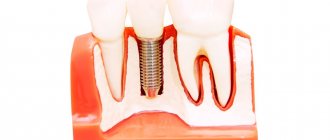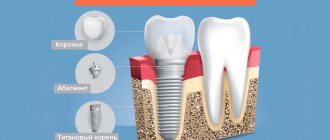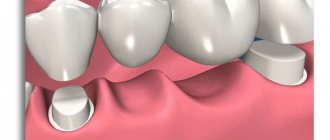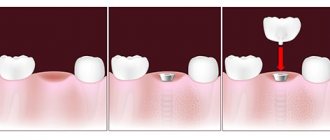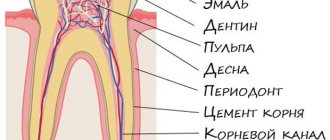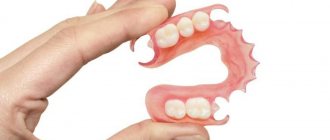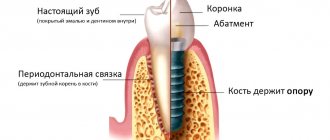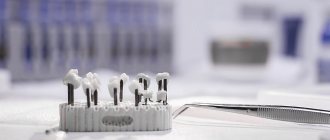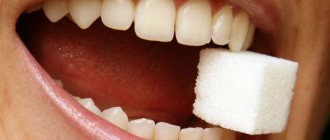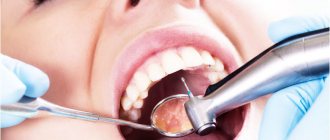Restoring chewing function by installing a prosthesis on titanium roots provides comfort for the patient and normalization of bone tissue trophism. Firmly fixed false teeth cope with the functions of natural teeth as physiologically as possible. However, implantation is not always possible. The disadvantages of the method are the presence of contraindications, complexity, price. In this case, the question arises: “What can be used instead of implants to lead a full life?” Dentistry "Dantistoff" offers alternatives to surgical methods of row reconstruction.
When an alternative to dental implants may be needed
Not everyone can get implantation. Contraindications for surgery:
- mental pathologies;
- immunodeficiency states;
- cancer;
- decompensated diabetes mellitus;
- rheumatism;
- problems with blood clotting;
- diseases of the central nervous system;
- diseases of bone tissue;
- inflammatory processes;
- severe heart pathologies;
- renal failure;
- increased sensitivity to antiseptics;
- age up to 18 years.
The list of contraindications varies depending on the implantation method. In addition to the restrictions on installing titanium roots, implantation has other disadvantages:
- relatively high cost of treatment;
- risk of implant rejection;
- the likelihood of damage to the maxillary sinuses (with prosthetics in the upper jaw row);
- complexity of the operation (the integrity of soft, bone tissue, nerve endings and mucous membranes is damaged - postoperative swelling and pain occur).
Contraindications
Implantation is a technique that allows a person to return the former beauty of his smile even with a very complex and extensive defect in the dental system.
But numerous studies conducted in recent years have shown that for successful osseointegration and full operation, it is necessary that the patient does not have any health problems during the period of implantation of the structure.
All existing restrictions on operations are divided into two categories - absolute (complete) and relative (temporary).
The difference between them is that the presence of at least one pathology from the list of absolute contraindications makes implantation impossible. If a relative limitation is identified, surgery is possible, but only after the patient’s condition has been stabilized.
The list of absolute contraindications includes the following conditions:
- pathologies of the circulatory system, especially poor blood clotting;
- malignant neoplasms of any location;
- psychoneurological abnormalities;
- thyroid diseases;
- connective tissue diseases developing in the maxillofacial area;
- allergy to metal alloys;
- HIV and sexually transmitted diseases;
- pathologies of bone tissue that inhibit the process of its regeneration;
- problems with the heart and blood vessels;
- tuberculosis;
- weakness of the immune system.
Relative restrictions include:
- inflammation of gum tissue;
- poor oral hygiene;
- periodontitis of periodontal tissues;
- bite pathologies;
- dysfunction of the mandibular temporal joint;
- pregnancy and breastfeeding;
- severe atrophy of the jaw bone;
- alcohol and drug addiction;
- exhaustion of the body.
Important! Before setting a date for implantation, the dentist must conduct an examination of the patient’s body to determine contraindications to this procedure. This approach allows you to avoid complications and emergency situations during and after surgery.
What can replace dental implantation?
Removable dentures
If the patient does not have money for implants, they make do with removable dentures, which can be inserted and removed from the mouth without the help of a dentist. The type of structure being installed determines the number of lost units:
- there are not several units in a row - partial structures are needed;
- If you need to replace your teeth, a full removable structure will help out.
The design of the removable product is made of plastic pink gums and artificial teeth. The structure includes a metal frame, hooks, and locks. If a complete denture is fixed, due to the gingival base, the product adheres to the mucous membrane (for reliability, patients use fixing creams and gels). The partial denture rests on healthy units with the help of hooks and clasps.
There are types of dentures:
- Bugelnye. The structures are used to restore several elements. They have a metal arc or clasp. The product is durable and can be fixed even on moving teeth. The service life of the structure is 7 years or more. Among the disadvantages, they note: low aesthetic value (fastenings are noticeable), relatively high price of prostheses. Condition for prosthetics: the presence of at least 2 supporting teeth in each row.
- Flexible. Dentures are made from soft hypoallergenic plastics - they are lightweight, comfortable to wear, and fit well to the gums. Partial flexible structures are supplemented with fastenings - plastic hooks. Products last 5-7 years or more. Among the disadvantages, they note: the impossibility of repairing or adjusting the prosthesis in the dentist’s chair (the product is repositioned by a dental technician). When wearing a soft structure, the atrophic process in the bone progresses faster (compared to a hard one).
- Acrylic. Plate structures are made of hard plastics - they are not comfortable to wear. The chewing load will be distributed on the gums, and not on the supporting units. Plus - low cost. Of the minuses, they note: the length of the period of adaptation, methyl ester of methacrylic acid in the composition of acrylic (irritates the mucous membranes).
Fixed dentures
Fixed structures are fixed in the oral cavity - the patient cannot remove them without the help of a dentist. The prosthesis has the form of a single dental crown or complex (dental bridge), which is “put on” the supporting teeth.
Bridge-like products rest on healthy neighboring elements (they are pre-ground). A locking dental bridge in the form of a single crown has a latch inside (the other two are on adjacent teeth). The adhesive structure is fixed to the supporting units, not covering them, but joining the tooth wall (preparation is excluded).
Fixed dentures have the following advantages:
- instantly restore the aesthetics and functionality of the dentition;
- biocompatible, hypoallergenic;
- do not rub the mucous membrane, do not create the sensation of a “foreign body” in the mouth;
- wear-resistant.
The disadvantages of fixed prosthetics include the high price and the need for support in the form of healthy teeth. In the absence of a large number of units, this support can only be implants.
Depending on the material, non-removable products are classified into:
- All-ceramic. The dentures are made of pressed ceramics; they are durable and resistant to chips, scratches and discoloration. The products are successfully used in the restoration of the frontal row.
- Metal-ceramic. One-piece construction consisting of a metal base and a coating in the form of aesthetic porcelain. Durable products can withstand significant loads. An allergic reaction to the metal is possible. Suitable for restoring chewing teeth.
- Zirconium. The basis of the design is zirconium dioxide, the coating is a layer of dental ceramics of a selected tone (similar to enamel). The prosthesis is durable, fits tightly to the supports, CAD/CAM technology guarantees the accuracy of the restoration. The disadvantage of zirconium prostheses is their high cost.
Recover adjacent teeth with braces
An alternative to implants and a bridge to replace the lateral teeth is to move adjacent units to replace the removed ones. The duration of therapy depends on the number of missing teeth and the time the patient walked without them. Treatment can last up to four years.
Before therapy, a thorough diagnosis is carried out and probable changes in the bite are predicted. Possible complications of therapy include resorption of bone tissue and exposure of tooth roots.
Price
Reconstructing teeth is not a cheap procedure. The total cost depends on many factors, the main ones being:
- model of the prosthetic structure;
- method of securing it;
- material of manufacture;
- number of teeth restored.
Of no small importance is the level of professionalism of the doctor, the pricing policy of the clinic and its location.
The table below shows approximate prices for various dental prosthetic methods.
| Recovery technique | Average cost, thousand rubles. |
| Implant with crown | from 30 |
| Removable nylon denture (partial, complete) | from 8 |
| Removable plate design | from 16 |
| Byugelny | from 45 |
| Reimplantation | from 2.5 |
| Single crown | from 5 |
| Bridge prosthesis | from 12 |
What is an alternative to implants for chewing teeth?
The chewing elements are more loaded than the anterior ones. The anatomy and localization of the units makes it difficult to care for the elements - the risk of developing dental diseases in the area of chewing teeth is high, the elements are susceptible to destruction.
If one or more teeth are missing in the chewing area, a dental bridge is placed, provided that there is something to attach it to - the adjacent units (including damaged ones) are pre-ground.
Among removable products, the use of a clasp design is justified - a durable option that does not bend under load. The product is secured with hooks or clasps.
The role of the doctor in choosing a treatment method
Often, already at the first consultation, the patient categorically declares: “I need an implant!” It sounds so confident that it seems that only the lack of appropriate tools is keeping the patient from doing it himself.
Before receiving the right to treat patients, a doctor studies for 6 years, then for 2 years he can undergo highly specialized training. Every 5 years he goes to improve his qualifications, but in fact he studies all his life, constantly gaining new experience, skills and knowledge. What can be concluded? Only a doctor can draw up an optimal rehabilitation plan and carry out the necessary manipulations.
Before starting treatment, a comprehensive clinical and radiological examination is carried out, and if necessary, the patient is referred for consultations to doctors of related specialties. Not only the extent of the dental defect is assessed, but also the condition of each remaining tooth, the quantity and quality of bone tissue, and the presence and severity of the patient’s general diseases. Only then will it be possible to make a diagnosis and formulate a treatment plan. Of course, the patient should be fully informed about both the treatment plan and alternative methods.
In conclusion, we would like to advise patients who have not decided on the choice of treatment method and who have no serious contraindications to pay attention to dental implants.
How to replace implants on front teeth
The frontal elements are not involved in chewing food, but high aesthetic demands are placed on them. As an alternative to implantation, a dental bridge is suitable for restoring teeth in the front row.
Metal-ceramic structures are not used in the smile area: the metal base darkens in the light; upon contact with metal, the mucous membrane may darken. Solid ceramics is a durable material, characterized by natural translucency, and looks like “your own” tooth. The most accurate, aesthetic and durable option is a zirconium dioxide prosthesis.
About implant brands and price differences
The most expensive implants are those made in Europe and the USA, but this does not mean that they have no alternative. We recommend paying attention to South Korean implants. Many are quite skeptical about products from Asia, but the medical industry of South Korea is not inferior to leading Western countries in terms of technological solutions. One of the best South Korean implant systems is Osstem. The company offers a wide range of implants and abutments that can solve the problem of partial and complete tooth loss in patients of various age and social groups. The possibility of 3D planning and the availability of special sets of tools for installing Osstem implants in conditions of bone deficiency makes it universal.
It is very important that the selected company producing implants has a distributor in your city who would not only sell this system, but also conduct courses, seminars, master classes and provide all the necessary technical support to doctors and patients. There is no need to save on your health by trusting systems that have not received a license and do not have official representation in Russia.
Which method is better to choose?
Implantation is a privileged way to restore lost elements in the absence of financial and clinical restrictions. Advantages of the method:
- Implants are durable. When installing a dental bridge, a replacement will be required after 5-7 years. The service life of implants is at least 25 years .
- Adjacent elements remain untouched. Implants do not require support. When installing a dental bridge, the supporting units are pre-ground, which leads to their destruction.
- Stopping bone atrophy. Implantation guarantees an even chewing load on the jawbone - the bone is not destroyed.
- Preservation of taste sensations. Removable structures dull the sense of taste due to the massive base blocking the receptors.
- Reliable fixation of prostheses and installation of various options for orthopedic structures.
Author of the article Voznyuk Vladimir Aleksandrovich Maxillofacial surgeon-implantologist of the highest category
Experience more than 30 years
Why is implant-supported prosthesis considered the best solution?
I.
The dental implant method allows you to restore lost teeth using single crowns, bridges and full dentures supported by implants. Such a prosthesis, even in the absence of all teeth, completely restores chewing function.
II.
The implant completely replaces the root of a natural tooth: it receives the load from the crown and distributes it to the bone tissue, so that it does not undergo atrophy. Simply put, with the help of dental implants, the doctor restores the natural function of chewing to the fullest extent possible. Feedback from patients about implantation, especially from those who have previously used prostheses of other designs, will be positive in the vast majority of cases.
III.
The service life of an intraosseous dental implant (if its installation was carried out efficiently) is practically unlimited. We see patients who had implants installed more than 30 years ago. Particular attention should be paid to self-discipline and compliance with all rules of oral hygiene. The patient must understand that the presence of implants increases the requirements for daily hygiene (using not only a toothbrush, but also an irrigator) and implies regular (2 times a year) professional oral hygiene. Thus, the long-term functioning of implants is not only the competent work of the doctor, but also the responsible attitude of the patient himself to his health.
Replantation
Replantation technology is considered an alternative to dental implants. The procedure is much cheaper than conventional implantation. It involves extracting the damaged tooth, treating it and fixing it in its original socket. To carry out the operation, a number of conditions must be met:
- There should be healthy units on both sides of the extracted tooth;
- The removal procedure is carried out carefully to avoid damage to the extracted tooth and the socket itself;
- The dentist sanitizes the area where the root was located.
After extracting the tooth, the prosthetist fills its canals and polishes the enamel. Then he returns back to his place. For fastening, the method of attaching a photopolymer thread to adjacent teeth is used.
After some time, the reimplant is implanted into the gum thanks to the medicine placed in the hole. Engraftment occurs within up to 3 months.
The replantation procedure is optimal, since the natural tooth quickly takes root and the risk of rejection is minimal. The cost of the method is cheaper than implantation. There are practically no contraindications.
Before choosing the appropriate prosthetic method, you should definitely consult with your personal dentist. In addition, it is important to study all the pros and cons of the chosen method of tooth restoration.
Reviews
If a person’s quality of life deteriorates due to the loss of teeth, it is necessary to urgently look for ways to restore them.
Yes, implantation today is one of the most effective methods of returning a beautiful smile, but there are many other types of prosthetics that can be chosen as a solution to the problem.
Share your personal experience of using alternative methods of replacing lost teeth in the “comments” section. Our readers will be interested in reading reviews from real people and appreciating this or that method of prosthetics.
If you find an error, please select a piece of text and press Ctrl+Enter.
Tags implantation fixed dentures removable dentures
Did you like the article? stay tuned
No comments yet

